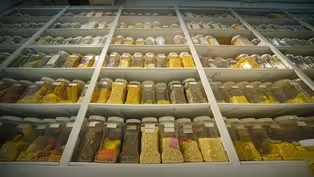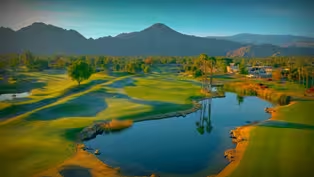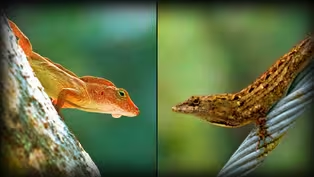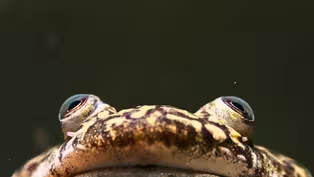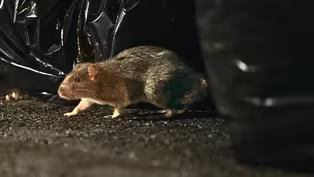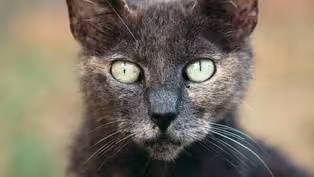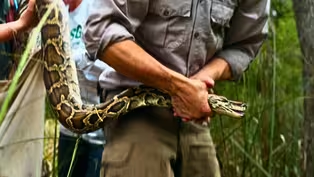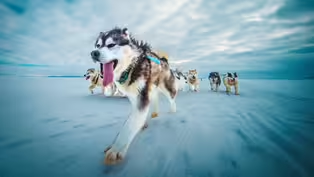
How Humans Are Reshaping Elephant Evolution
Special | 11m 57sVideo has Closed Captions
Uncover the impact of hunting on elephant genetics.
Host and evolutionary biologist Shane Campbell-Staton uncovers the impact of hunting on elephant genetics. From Mozambique's Gorongosa National Park to the scars left on the elephant population, Shane's research is revealing how our actions can change the course of evolution itself.
Problems playing video? | Closed Captioning Feedback
Problems playing video? | Closed Captioning Feedback

How Humans Are Reshaping Elephant Evolution
Special | 11m 57sVideo has Closed Captions
Host and evolutionary biologist Shane Campbell-Staton uncovers the impact of hunting on elephant genetics. From Mozambique's Gorongosa National Park to the scars left on the elephant population, Shane's research is revealing how our actions can change the course of evolution itself.
Problems playing video? | Closed Captioning Feedback
How to Watch Human Footprint
Human Footprint is available to stream on pbs.org and the free PBS App, available on iPhone, Apple TV, Android TV, Android smartphones, Amazon Fire TV, Amazon Fire Tablet, Roku, Samsung Smart TV, and Vizio.
Buy Now

Surprising Moments from Human Footprint
Do you think you know what it means to be human? In Human Footprint, Biologist Shane Campbell-Staton asks us all to think again. As he discovers, the story of our impact on the world around us is more complicated — and much more surprising — than you might realize.Providing Support for PBS.org
Learn Moreabout PBS online sponsorshipMore from This Collection
Video has Closed Captions
Watch the rise of a productive crop that has managed to replace itself, but at what cost? (11m 24s)
The Watery Price Of Golf Courses & Lawns
Video has Closed Captions
The cultural and resource costs for manicured lawns and golf courses are quite shocking. (11m 29s)
How Dogs Are Shaping The Future Of Medicine
Video has Closed Captions
Observe the rich diversity of dog breeds, shaped by genes and human intervention. (12m 43s)
We Brought This Fish To America. Now We Can't Get Rid Of It
Video has Closed Captions
Expose Asian carp for disrupting native fish species and shrinking their populations. (10m 39s)
Why Are These Urban Lizards Evolving in Overdrive?
Video has Closed Captions
Examine city-dwelling anoles with remarkable evolutionary changes. (10m 33s)
How An Ancient Ocean Shaped Us History
Video has Closed Captions
Learn how millions of years of deposits shaped the events of Black American history. (16m 54s)
Video has Closed Captions
What happens when frogs become indispensable? (8m 59s)
Video has Closed Captions
When it comes to NYC, the rat is the undisputed king! (13m 26s)
Your Cat’s Secret Life (as a Deadly Predator)
Video has Closed Captions
Cats have been winning the hearts of humans for years....but can devastate ecosystems. (10m 40s)
Singapore: Designing a Megacity in Harmony with Nature
Video has Closed Captions
Green spaces aren't just an afterthought here - they're mandatory! (13m 24s)
How Giant Pythons Became Florida’s Biggest Invasive Species
Video has Closed Captions
Ever heard of the phrase "when pet pythons outgrow their owners"? (13m 24s)
Sled Dogs: The Most Extreme Distance Athletes on Earth
Video has Closed Captions
In the Arctic, it's not just about muscle power, but brainpower too. (15m 17s)
Providing Support for PBS.org
Learn Moreabout PBS online sponsorshipIs this a perfect morning for you, going out and looking for elephants?
It is.
Yeah.
This is very recent.
No?
Well, we got a tree in the middle of the road.
Elephant pushed it over looking for palm fruits.
Dominique, you think this is elephant damage?
Elephant maintenance?
Yeah.
Elephant maintenance.
I like that.
Gorongosa National Park in Mozambique is one of the jewels of southern Africa.
If you’re lucky enough to visit, you might even spot some elephants, although Gorongosa’s elephants have a reputation for being hard to find.
And that’s not the only thing that makes these elephants different: A lot of Gorongosa’s elephants are tuskless.
I’m evolutionary biologist Shane Campbell-Staton, and my research brought me here in 2017 to try and understand why – and now, years later, we’re starting to unravel the mystery behind the unexpected and rapid evolution of these elephants.
In this show, we’ll discover how ONE species – humans – is reshaping the world and determining the future of every other form of life.
And it’s more than just our basic needs – even our whims have a global impact.
We can destroy – and create – at a scale our world has never seen.
So what will be the legacy that defines our species’ history?
This is Human Footprint.
This is my friend DOMINIQUE Gonçalves.
She runs the elephant ecology project here.
Knowing where the park's elephants are is a big part of her job.
But they don't make it easy.
Incredible to me that an animal that big can be so cryptic.
And ambush you.
Yeah.
Can you see it from there?
Yeah.
I see her.
You can hear it.
Ma’Ca’Pu You can hear something off in the palms.
We have arrived.
Welcome to Paradise.
When you see them up close, the tuskless elephants are hard to miss.
Female African elephants normally have tusks, just like the males.
But more than a third of Gorongosa’s females have no tusks at all.
To understand what happened, you need to know a little about Mozambique’s history.
Well, you have to remember, Gorongosa was one of the battlefields.
MmmHmm.
And a lot of bad things happened in this place during the war.
Dominique is talking about the Mozambican civil war: a bloody conflict that raged from 1977 to 1992.
You can still see the scars of war all over the park.
The driving force of conservation is people.
If people are poor, you are not going to succeed.
This is Pedro Muagura.
Gorongosa’s Park Warden.
When he's not managing the park's million-plus acres of forest, wetland and savanna, he's getting his hands dirty planting trees…and singing for anyone who will listen.
The Gorongosa I'm seeing today is very different from what existed here before the war.
Before civil war, this park was very rich.
When we talk about top two in Africa, we're talking about Serengeti, Gorongosa, Kruger National Park.
Pedro’s first experience of Gorongosa was in 1992 – right after the Civil War.
I was teaching forestry and wildlife management, and I used to come with the students to do animal identification.
The problem was, there weren't many animals left to identify.
In terms of mammals.
We used to spend 2 to 3 days to view one baboon.
To view baboon.
I'm not talking about lion.
I’m not talking about elephant.
The war had devastated the park’s wildlife.
When you have war, the first area to be destroyed is Nature.
Protected areas.
Forestry.
Wild animals here were used like bank.
They used to exchange these wild animals’ products with ammunitions, firearms, uniforms.
Many species were hunted to provision the armies with meat.
But elephants – with their ivory tusks – were an even more valuable commodity.
Gorongosa’s elephant population crashed from 2500 to less than 200… a loss of more than 90% in just 16 years.
And half the female survivors were tuskless – nearly three times as many as before the war.
Researchers began to think that the intense ivory poaching during the war had literally changed the face of Gorongosa’s elephant population.
It wouldn’t be unprecedented for hunting to drive evolution.
In fact, one of the earliest measurements of natural selection in the wild comes from foxes hunted for their furs in Canada.
Some foxes carried a genetic mutation, giving them a silver coat instead of red, making their pelts more valuable.
But after a century of hunters targeting these silver foxes, that mutation became rare.
But elephants aren’t foxes.
They live for decades and reproduce slowly.
Could poaching cause elephants to evolve in just 16 years?
When I arrived in Gorongosa, we knew that tuskless females, once a rarity, had become more common.
Thanks to researchers like Dominique, we'd also learned that tuskless females often have tuskless female offspring.
But no one knew which genes encoded tusklessness, or whether those genes had undergone natural selection during the war.
So we needed elephant DNA.
We’re looking for genes that are consistently different… There it is.
Between elephants with and without tusks.
And in Gorongosa’s elephants, we found two.
One is a gene called AMELx.
In humans, mutations in this gene cause a condition called amelogenesis imperfecta.
Women with this condition often don’t develop their upper lateral incisors, which are the teeth right next to your two front teeth… And in elephants, they’re exactly the teeth that develop into tusks!
Since AMELX differed between tusked and tuskless females, and it has this known effect in humans, we feel pretty confident that this gene is part of the reason so many Gorongosa elephants don’t have tusks.
After the civil war, tuskless females were among the last elephants standing And they passed that trait on to their female offspring, who now live in a population very different from the one their mothers grew up in.
Human hunting really did drive the evolution of the world's largest land animal.
Okay.
Are we ready?
Let’s rock.
Awww yeah.
You’ll see once we hit the Urema River.
We’ll go up, hopefully get around to the floodplain.
Awesome.
That sounds awesome.
Also, looking for some elephants, we saw on the way in earlier.
It’s a nice hot day, and these guys love water.
Look at all those ele[phant]s crossing.
Oh my God.
That’s incredible.
They got some little ones with ‘em.
Yeah Yeah.
There’s some tuskless ladies.
Yeah, you can see the one on the right is tuskless.
Yeah.
And the one leading up front now.
Elephants can't decide whether or not to grow tusks.
But here in Gorongosa, we decided for them.
It’s incredible to think that an entire ecosystem that’s been going for millions of years.
And we've come along in 15 years – 15 years – and fundamentally changed aspects of this ecosystem, it’s absolutely incredible.
I think it speaks to the power of who we are as a species.
Seeing the park from above is also a good reminder that this story isn't just about elephants.
Elephants are connected to everything else here, too.
They have an oversized role to play in this ecosystem, and their tusks are part of that role.
The elephants use them to, you know, the tusks to debark trees, and dig holes and fight the males.
And if an elephant can't knock down a tree or eat properly, how does that have this domino effect all the way to the ecosystem, and then to us?
So there's many, many questions.
Questions that Gorongosa’s elephants can help us answer someday, now that they’re better protected from poaching.
Today, at more than a thousand strong, this population is bouncing back.
For me, it’s like how, it shows a lot of how resilient they are.
They carry this past, heavy past, this trauma, which, you know, makes them extremely aggressive or less tolerant to people.
Yeah.
To us.
But maybe these elephants can sense that they aren’t being hunted anymore.
Okay, everyone, stay quiet.
That’s him.
You can’t yet prove it, but you can see that some of them are becoming more tolerant.
I don't think they forget.
Yeah.
An elephant never forgets.
But maybe they can be on the road to forgiveness?
Yeah, forgiveness, exactly.
It's not forgetting, but might be forgiveness.
This will never not be incredible.
In today's Gorongosa, researchers like Dominique think that tusks are probably an asset for elephants rather than a liability.
So with time… maybe these herds will start to look like other elephants again.
For now, Gorongosa’s tuskless elephants are a living testament to the power of our species to re-shape nature and even drive the evolution of the world’s largest land animal.
Thanks for watching!
If you want more Human Footprint, you can tune in to the full length series on the PBS App or on your local PBS station.

- Science and Nature

Explore scientific discoveries on television's most acclaimed science documentary series.

- Science and Nature

Capturing the splendor of the natural world, from the African plains to the Antarctic ice.












Support for PBS provided by:
